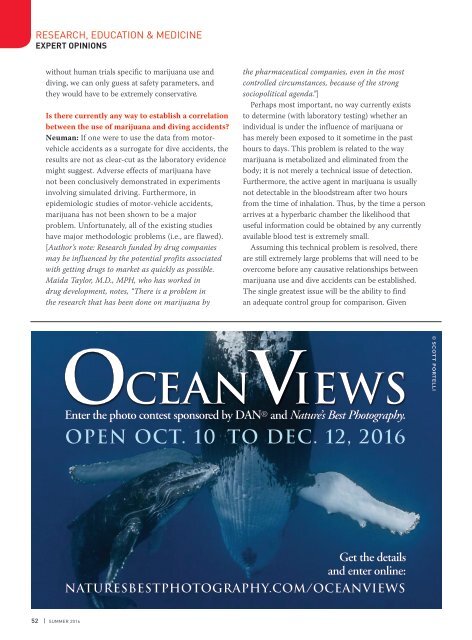AD 2016 Q3
Alert Diver is the dive industry’s leading publication. Featuring DAN’s core content of dive safety, research, education and medical information, each issue is a must-read reference, archived and shared by passionate scuba enthusiasts. In addition, Alert Diver showcases fascinating dive destinations and marine environmental topics through images from the world’s greatest underwater photographers and stories from the most experienced and eloquent dive journalists in the business.
Alert Diver is the dive industry’s leading publication. Featuring DAN’s core content of dive safety, research, education and medical information, each issue is a must-read reference, archived and shared by passionate scuba enthusiasts. In addition, Alert Diver showcases fascinating dive destinations and marine environmental topics through images from the world’s greatest underwater photographers and stories from the most experienced and eloquent dive journalists in the business.
Create successful ePaper yourself
Turn your PDF publications into a flip-book with our unique Google optimized e-Paper software.
RESEARCH, EDUCATION & MEDICINE<br />
EXPERT OPINIONS<br />
without human trials specific to marijuana use and<br />
diving, we can only guess at safety parameters, and<br />
they would have to be extremely conservative.<br />
Is there currently any way to establish a correlation<br />
between the use of marijuana and diving accidents?<br />
Neuman: If one were to use the data from motorvehicle<br />
accidents as a surrogate for dive accidents, the<br />
results are not as clear-cut as the laboratory evidence<br />
might suggest. Adverse effects of marijuana have<br />
not been conclusively demonstrated in experiments<br />
involving simulated driving. Furthermore, in<br />
epidemiologic studies of motor-vehicle accidents,<br />
marijuana has not been shown to be a major<br />
problem. Unfortunately, all of the existing studies<br />
have major methodologic problems (i.e., are flawed).<br />
[Author’s note: Research funded by drug companies<br />
may be influenced by the potential profits associated<br />
with getting drugs to market as quickly as possible.<br />
Maida Taylor, M.D., MPH, who has worked in<br />
drug development, notes, “There is a problem in<br />
the research that has been done on marijuana by<br />
the pharmaceutical companies, even in the most<br />
controlled circumstances, because of the strong<br />
sociopolitical agenda.”]<br />
Perhaps most important, no way currently exists<br />
to determine (with laboratory testing) whether an<br />
individual is under the influence of marijuana or<br />
has merely been exposed to it sometime in the past<br />
hours to days. This problem is related to the way<br />
marijuana is metabolized and eliminated from the<br />
body; it is not merely a technical issue of detection.<br />
Furthermore, the active agent in marijuana is usually<br />
not detectable in the bloodstream after two hours<br />
from the time of inhalation. Thus, by the time a person<br />
arrives at a hyperbaric chamber the likelihood that<br />
useful information could be obtained by any currently<br />
available blood test is extremely small.<br />
Assuming this technical problem is resolved, there<br />
are still extremely large problems that will need to be<br />
overcome before any causative relationships between<br />
marijuana use and dive accidents can be established.<br />
The single greatest issue will be the ability to find<br />
an adequate control group for comparison. Given<br />
oceanviews<br />
Enter the photo contest sponsored by DAN ® and Nature’s Best Photography.<br />
open oct. 10 to dec. 12, <strong>2016</strong><br />
© SCOTT PORTELLI<br />
Get the details<br />
and enter online:<br />
naturesbestphotography.com/oceanviews<br />
52 | SUMMER <strong>2016</strong>









